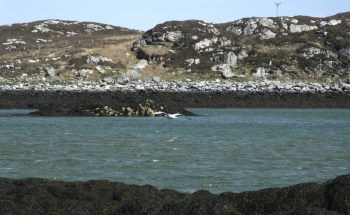| This article is incomplete. This article is missing one or more sections. You can help the BirdForum Opus by expanding it. |
Overview
The RSPB bought the 1221-ha reserve at the west end of the Isle of Coll in 1991. Coll lies 54 miles northwest of Mull and the reserve consists of 2 huge dunes, large areas of grazing land, heather moorland and hay meadows. The dune systems lie between 2 wide bays with sandy beaches and rocky headlands - Feall Bay on the north and Crossapool Bay on the south. These bays are important for wintering wildfowl.
Birds
Notable Species
The RSPB established the reserve for Corncrake. Numbers have remained fairly stable on Coll and Tiree despite national declines, partly due to RSPB initiatives with local crofters and farmers. 28 males were recorded on the reserve in 1996.
The machair-moorland on the reserve provides breeding habitat for Snipe, Dunlin, Lapwing and Redshank.
Other notable breeders include Rock Dove, Twite and Raven. Hen Harrier, Peregrine, Short-eared Owl and Merlin can also occur. Red-throated Diver, Greylag Geese, Teal, Arctic Skua, Fulmar, Eider, Shag, and Common Tern, Arctic Tern and Little Tern all breed on Coll.
Off-shore seabirds can include Gannet, Arctic Skua and Great Northern Diver. Puffin, Guillemot, Razorbill and Manx Shearwater all breed at the nearby Treshnish Isles and so can be seen offshore.
In winter, Coll has important breeding populations of Greenland White-fronted Geese and Barnacle Geese as well as the Greylags. A flock of feral Snow Geese occur on the reserve and Long-tailed Duck, Scaup and Common Scoter can all occur in the bays.
Rarities
Check-list
Birds you can see here include:
"to do"
Other Wildlife
The coastline can be good for Otters. Porpoises, Dolphins, Basking Sharks, some Whales and Common Seal are all possible.
Site Information
History and Use
Areas of Interest
Access and Facilities
Coll is reached by ferry from Oban. The company Caledonian MacBrayne operate a service four days a week in the summer and three days a week in the winter. Booking is essential for vehicles which can use the roll-on/roll-off facility. The ferry also calls at Tiree and foot passengers can board at Tobermory on Mull.
Once on Coll, the B8070 south from Arinagour, leads to the reserve. Turn left at Arileod and continue for just over half a mile, bearing right at the turn-off to the Castle, then parking just past the cattle grid.
The reserve is open all year.
Grid Ref: NM167563
Contact Details
RSPB Warden - Charlie Self, Roundhouse, Coll (tel: 01879 230301)






